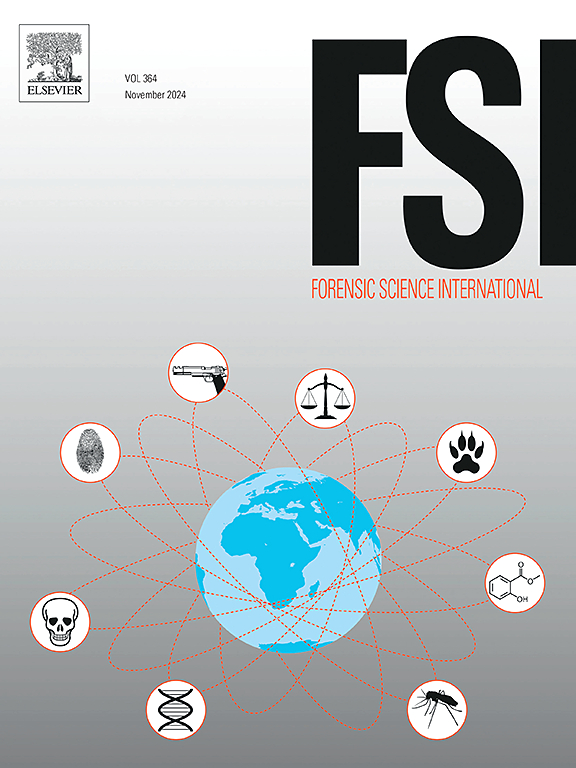Chemsex-related deaths in the United Kingdom (2017–2022): A review of the Forensic Toxicology data
IF 2.5
3区 医学
Q1 MEDICINE, LEGAL
引用次数: 0
Abstract
Background
The colloquial term “chemsex” (or “party and play”) has appeared within the media and scientific literature within the past decade or so. It has been described as “sex, sometimes long sessions with multiple partners, under the influence of psychoactive drugs (particularly mephedrone, GHB, GBL and crystal meth). Subjects are reported to be mostly, but not exclusively, men who have sex with men (MSM).
The study presents toxicology data from 21 deaths in the United Kingdom (between 2017 and 2022) considered within the “chemsex” scenario.
Method
Each case (n = 21) involved the anecdotal report of using drugs with sexual activity. The age of the decedents was 19–62 years (median age = 42). 17 males died after pre-arranged meetings with other males. 2 males died after apparently engaging in sex acts alone. 1 male died after meeting a female. 1 female died after meeting a male. Volatile substance abuse and physical restraints were mentioned in some cases (“poppers”, ethyl chloride).
Post-mortem samples were analysed in 19 cases. In 2 cases, the subject was found alive, but died later. Ante-mortem blood samples were analysed in these 2 cases.
Analysis was carried out for alcohol, drugs of abuse, medicines and a range of sedative substances using conventional chromatographic methods including Gas Chromatography with Flame Ionisation Detector (GC-FID), Gas Chromatography Mass Spectrometry (GC-MS), Gas Chromatography with Tandem Mass Spectrometry (GCMS/ MS), Liquid Chromatography with Tandem Mass Spectrometry (LC-MS/MS) and Liquid Chromatography with High Resolution Accurate Mass Spectrometry (LCHRAM).
Results
Methamphetamine (methylamphetamine, MA, n = 16) and GHB (n = 14) were the most common drugs detected. The concentration range for MA was 0.025–13 mg/L, and for GHB was 22 to > 800 mg/L in blood.
1 case contained mephedrone (0.19 mg/L).
Other drugs detected included: sildenafil/tadalafil (n = 9); cocaine/benzoylecgonine (n = 7); alcohol (n = 4); ketamine (n = 4); cannabis (n = 3); diazepam (n = 1); quetiapine (n = 1); diphenhydramine (n = 1).
Poly drug use was common. The most common combination was MA and GHB (n = 11).
The cause of death was predominantly given as Drug toxicity/Drug-related death. Ischaemic heart disease/coronary atherosclerosis was listed as an additional complication in some cases.
Conclusions
Methamphetamine and GHB were the most common drugs observed. Poly-drug use is common in deaths associated with chemsex. Little use of mephedrone was found. Volatile use/asphyxia may be a significant factor. We believe this is the first single study providing toxicology data in a series of chemsex-related deaths in the UK.
英国化学品相关死亡(2017-2022):法医毒理学数据综述
通俗的术语“chemsex”(或“派对和游戏”)在过去十年左右的时间里出现在媒体和科学文献中。它被描述为“在精神药物(特别是甲氧麻黄酮、g - b、GBL和冰毒)的作用下,与多个伴侣进行长时间的性行为”。据报道,研究对象主要是男男性行为者(MSM),但并非全部。该研究提供了英国(2017年至2022年)21例死亡的毒理学数据,这些死亡被认为属于“化学性”情景。方法每例病例(n = 21)均涉及与性行为同时使用药物的轶事报道。死者年龄19-62岁,中位年龄42岁。17只雄性在事先安排与其他雄性会面后死亡。2名男性显然是在单独进行性行为后死亡的。1名男性在遇到一名女性后死亡。1名女性在遇到一名男性后死亡。在某些情况下提到了滥用挥发性药物和人身限制(“罂粟花”、乙基氯)。对19例尸体标本进行了分析。在2个案例中,受试者被发现时还活着,但后来死亡。对这2例患者进行了死前血样分析。使用常规色谱方法对酒精、滥用药物、药物和一系列镇静物质进行了分析,包括气相色谱-火焰离子化检测器(GC-FID)、气相色谱-串联质谱(GC-MS)、气相色谱-串联质谱(GCMS/ MS)、液相色谱-串联质谱(LC-MS/MS)和液相色谱-高分辨率精确质谱(LCHRAM)。结果甲基苯丙胺(甲基安非他明,MA, n = 16)和GHB (n = 14)是检出最多的毒品。血中MA浓度范围为0.025 ~ 13 mg/L, GHB浓度范围为22 ~ 800 mg/L。1例含甲氧麻黄酮(0.19 mg/L)。其他检出的药物包括:西地那非/他达拉非(n = 9);可卡因/ benzoylecgonine (n = 7);酒精(n = 4);氯胺酮(n = 4);大麻(n = 3);安定(n = 1);喹硫平(n = 1);苯海拉明(n = 1)。多种药物的使用是常见的。最常见的组合是MA和GHB (n = 11)。死亡原因主要是药物毒性/药物相关死亡。缺血性心脏病/冠状动脉粥样硬化被列为某些病例的额外并发症。结论甲基苯丙胺和GHB是最常见的药物。多种药物的使用在与化学性相关的死亡中很常见。很少发现甲氧麻黄酮的使用。挥发性使用/窒息可能是一个重要因素。我们相信这是第一个为英国一系列与化学品有关的死亡提供毒理学数据的单一研究。
本文章由计算机程序翻译,如有差异,请以英文原文为准。
求助全文
约1分钟内获得全文
求助全文
来源期刊

Forensic science international
医学-医学:法
CiteScore
5.00
自引率
9.10%
发文量
285
审稿时长
49 days
期刊介绍:
Forensic Science International is the flagship journal in the prestigious Forensic Science International family, publishing the most innovative, cutting-edge, and influential contributions across the forensic sciences. Fields include: forensic pathology and histochemistry, chemistry, biochemistry and toxicology, biology, serology, odontology, psychiatry, anthropology, digital forensics, the physical sciences, firearms, and document examination, as well as investigations of value to public health in its broadest sense, and the important marginal area where science and medicine interact with the law.
The journal publishes:
Case Reports
Commentaries
Letters to the Editor
Original Research Papers (Regular Papers)
Rapid Communications
Review Articles
Technical Notes.
 求助内容:
求助内容: 应助结果提醒方式:
应助结果提醒方式:


